
From kitchenware to commando companions, we go over how Gerber Knives became legendary and some of their all-time best offerings.
Gerber Legendary Blades, often known as just Gerber among the knife community (not to be confused with the equally legendary makers of fine baby foods and formula), is a name that you’ve probably heard. It’s hard to go into any outdoor store without finding one of its many blades.
But how much do you really know about the company?
Today, we’re going to do a deep dive into this iconic knifemaker that has helped shape the knife industry for so many years. We’re going to cover everything from its history to its new and exciting premium knife offerings, along with all the truly legendary knives it’s released along the way.
Let’s get started.
History of Gerber Knives
Cooked Up In The Kitchen
In the early 1900s, the Gerber family began their corporate climb with a simple advertising firm in Portland Oregon. As a promotion, Joseph Gerber sent out 24 sets of handmade kitchen knives to clients during the holidays.
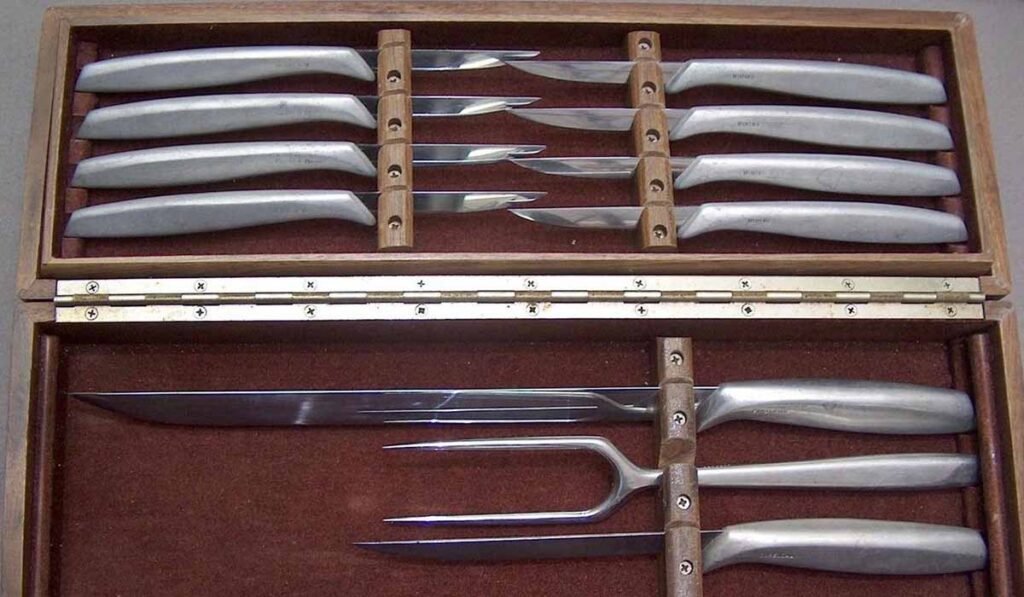
These proved so popular that Abercrombie & Fitch, then one of the largest catalog retailers, requested more for its 1939 spring edition. Gerber Legendary Blades was then founded shortly after.
Originally, Gerber focused on camp, kitchen, and carving knives, and did brisk business around the holidays and wedding season in the spring when many registries included a new kitchen knife set for happy couples.
Off To War
Following WWII, Gerber expanded its focus and began to work on knives for military contracts, including the now-legendary Mark II fighting knife. Al Mar, a prolific knife designer, added some serrations to the blade allowing it to be marketed as a survival knife as well.
Since then, the Mark II has been discontinued in favor of the Prodigy and LMF II knives, which are both in service with various militaries. The LMF II in particular currently sees services as an aircraft survival knife. It features a specially insulated handle so that downed pilots can cut their way free of airframes without risk of an electrical shock, even if they have to cut through the fuselage of the aircraft.
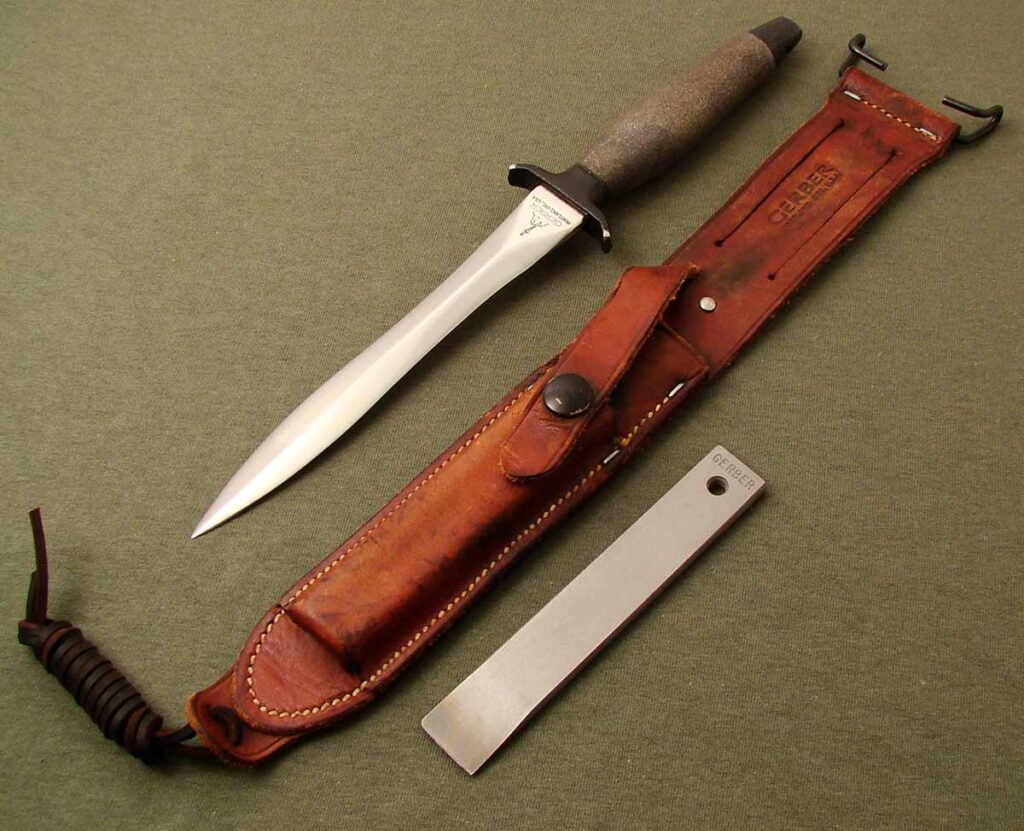
Other Gerber knives such as the often-imitated LST lockback folder changed the shape of the knife-making landscape forever. The 06 Auto was, and is, hugely popular with U.S. and NATO forces in the Middle East and has earned a reputation as a tough piece of gear that gets the job done.
Into Every Niche
Gerber has also collaborated with a wide variety of knife makers and designers, as well as police trainers, special forces operators, and world-class martial artists to design hard-use knives that meet any need in the field.
One of my personal favorites is Gerber Guardian, a “boot knife” designed by Bob Loveless—the man who popularized the hollow-ground drop-point blade—and is generally considered one of the most innovative knife designers to ever live.
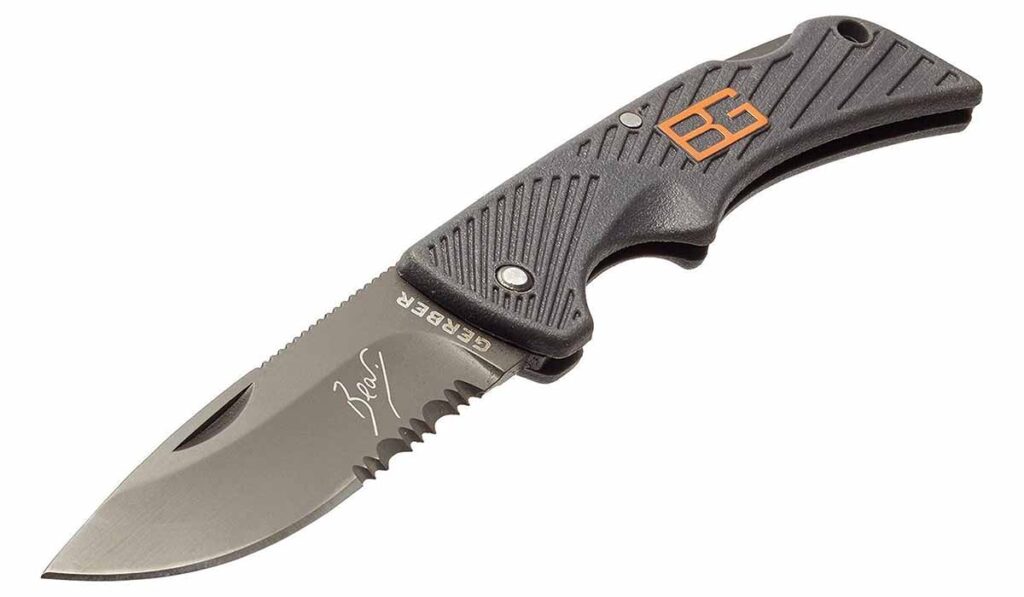
Another, now collector’s item, is the River Master, a collaboration with legendary knife maker Blackie Collins. The River Master is an aggressive dive knife designed to cut through fishing lines, nets, vegetation, and other obstacles that can spell doom for a diver—particularly in murky water.
Blackie Collins, incidentally, gave us the assisted-opening spring mechanism that so very many knives today use, including the 06 FAST, the more budget-friendly, non-automatic version of the 06 Auto. Not to mention he was the founder of a little publication called American Blade (i.e. Blade Magazine).
There’s also the Bear Grylls collection, which includes the top-selling Ultimate Pro knife, which has become somewhat iconic in the years since its release. The original Ultimate was a bit of a flop as Gerber outsourced more of its manufacturing and quality control suffered.
Thankfully, Gerber has taken things more firmly in hand these days, and while it still offers a variety of very budget-focused “beater” knives, its premium Reserve offerings stand tall with the best of the best in the production knife world today.
Are Gerber Knives Any Good?
Yes, Gerber knives are good. The company’s more affordable lineup offers great value for the budget-conscious, and their higher-end offerings (particularly the Reserve line) are as good as anything you’ll find in the world of production knives.
Don’t make the mistake of thinking those $7.99 knives on the clearance rack in the camping section of your local big box store are all Gerber has to offer these days.
The new(ish) Fastball cleaver, the Sedulo, Terracraft, and the now-iconic 06 Auto are all incredible knives I can personally vouch for (we’ll talk more about them later, plus a few other iconic Gerber knives).
Today, Gerber also remains one of the largest suppliers of knives to the U.S. military and has grown into one of the most respected names in the knife industry. Though owned by Fiskars, a Finnish company also known for great blades, most of Gerber’s best knives are made right here in the US as well.
As a great man in the knife industry has often said, quality is about effort, not geography. But it’s always nice to support the home team, especially when it comes to knives.
All-Time Greats: Best Gerber Knives to Pay Attention To
06 Auto
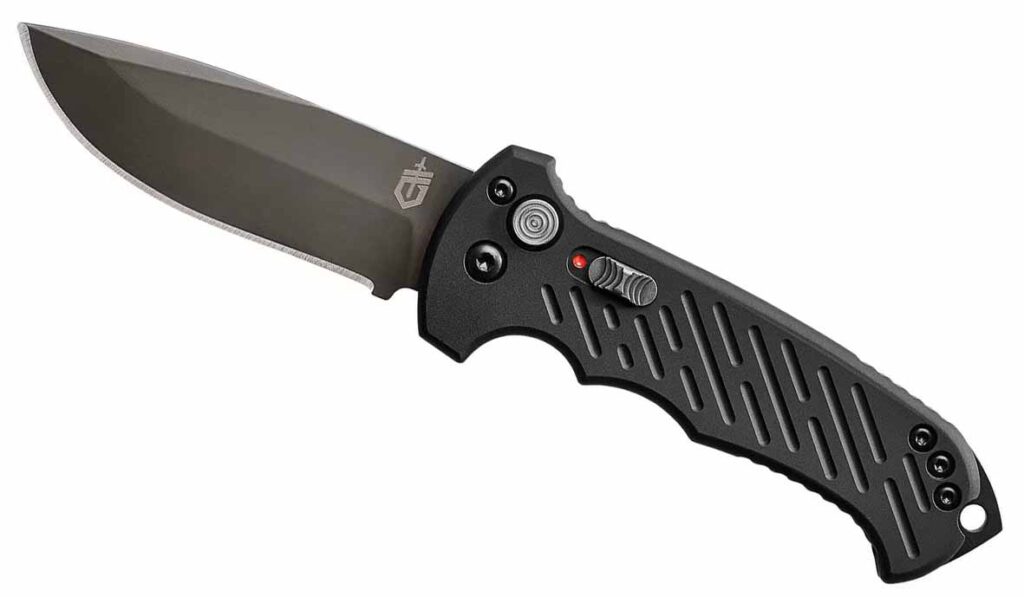
The Gerber 06 Auto has been a top seller for ten years now and has been a big hit with US forces in Iraq and Afghanistan. This is a knife that has been issued to US forces and flown off the shelves at the PX as well, so it’s safe to say it has the military’s stamp of approval.
It’s an automatic opening knife, with a 3.6-inch CPM S30V blade. The auto opening and the blade length make it a very useable knife for everything from camp meal prep to self-defense but be sure to check your local regulations before picking one up.
My time with the 06 Auto has been great, and I’ve used it for all kinds of cutting and sawing tasks around camp and even used it to open a “spam can” of Russian surplus 7.62x54R ammo out in the desert when we absolutely had to have the ammo for a video shoot.
All in all, a great knife, with a battle-proven pedigree.
Mark II
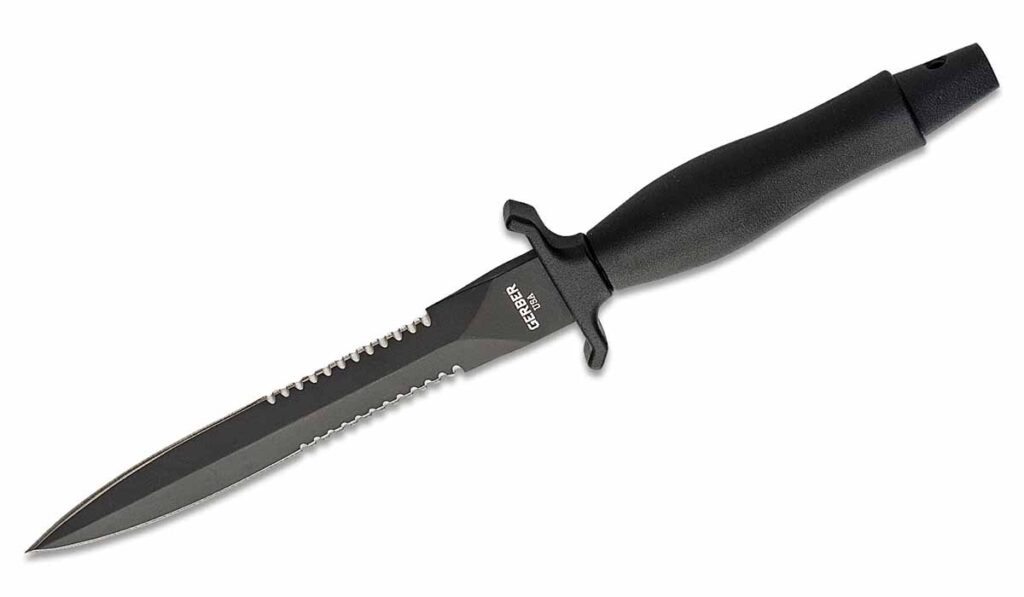
The Mark II was introduced just before the kickoff of the American involvement in Vietnam and is one of the most popular knives around. It features a 6.6-inch 420HC double-edged blade with a black oxide coating. It also features serrations on both sides near the handle, giving it its iconic look.
It was originally conceived as a fighting knife by Captain Bud Holzmann, who based the design on a Roman Gladius, specifically the Mainz Gladius, which is a very famous example of the Roman blade that was found in the Mainz River.
The knife overall takes some cues from the Fairbairn-Sykes fighting knife issued to British commandos and was the second-most commonly carried knife by American Troops in Vietnam, only behind the iconic Ka-Bar.
The knife has also been quite famously featured in films like The Road Warrior as the knife carried by Max himself, in Aliens (the cafeteria scene), in the excellent knife fight scene in Captain America: Winter Soldier, and in the bananas knife fight scene at the end of Under Siege with Stephen Seagal.
LMF II Infantry
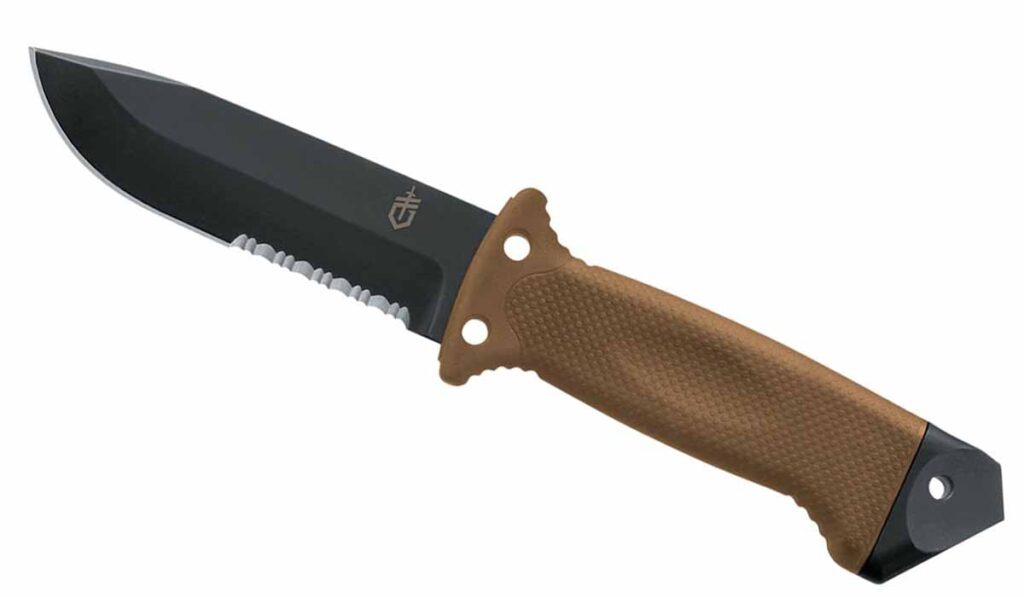
Currently, the LMF II Infantry is Gerber’s primary tactical fixed blade, and a great option if you need something robust that can be used in the field for just about anything from camp tasks to self-defense (or offense, if you have a profession that sends you into dangerous situations on purpose).
The blade is 4.84 inches of 420HC stainless with a full tang and a striker pommel that can be used for pounding tent stakes, breaking glass, or whatever other tactical shenanigans you need a striking tool for.
It also has partial serrations near the guard to allow for quick work sawing tasks, especially if you need to cut rope or thin lengths of wood in a hurry. Or use it to saw open a can because Kevin forgot the can opener.
The ASEK version has an insulated handle and a partial tang, so it’s less suited for civilian tasks like processing firewood or what have you, but better for say, cutting your way out of a downed aircraft.
Unless you’re a bush pilot, or cutting copper out of drywall for totally legal and normal reasons, the regular AESK is probably the better option for most folks.
Sedulo
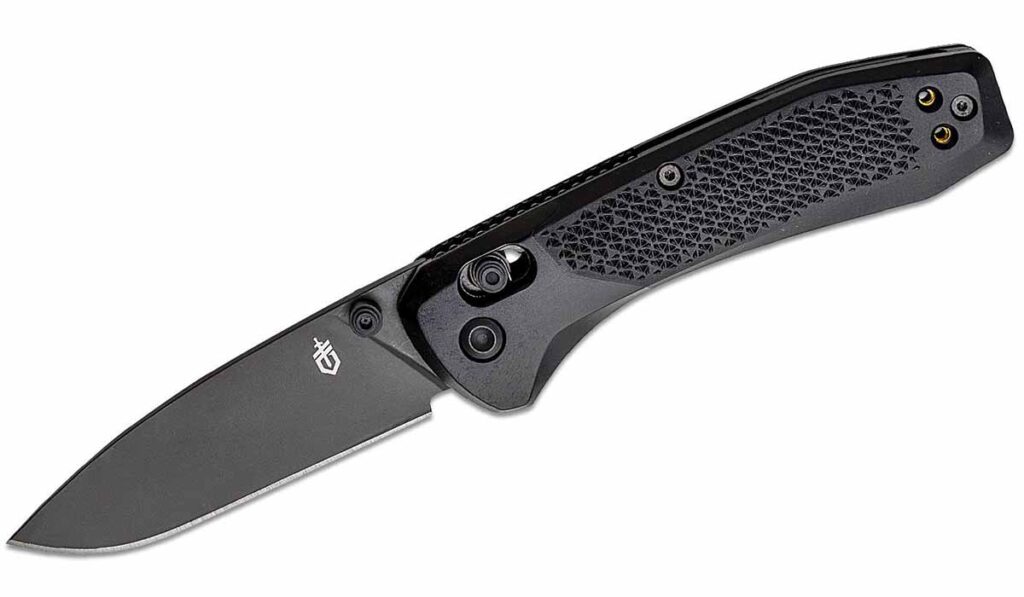
The Sedulo is a new favorite among Gerber fans, and it takes a bit of inspiration from another insanely popular knife, the Benchmade Bugout, including Gerber’s version of Benchmade’s Axis lock (called the Pivot Lock).
The basic version retails for less than the Bugout and features a reversible deep-carry pocket clip, a textured FRN handle, and a 3.4-inch CPM S30V stainless blade. That blade length is uncontroversially under 3.5 inches, which is a key cut-off point in many areas in terms of what you can carry, by the way.
Gerber hasn’t reinvented the wheel here, but they have produced a rock-solid EDC knife with all the modern features we’d expect and is made in America, at a price that won’t lead to any tears when it’s time to whip the debit or credit card out.
All in all, the knife is something worth paying attention to and a promising direction for the company.
Fastball Cleaver
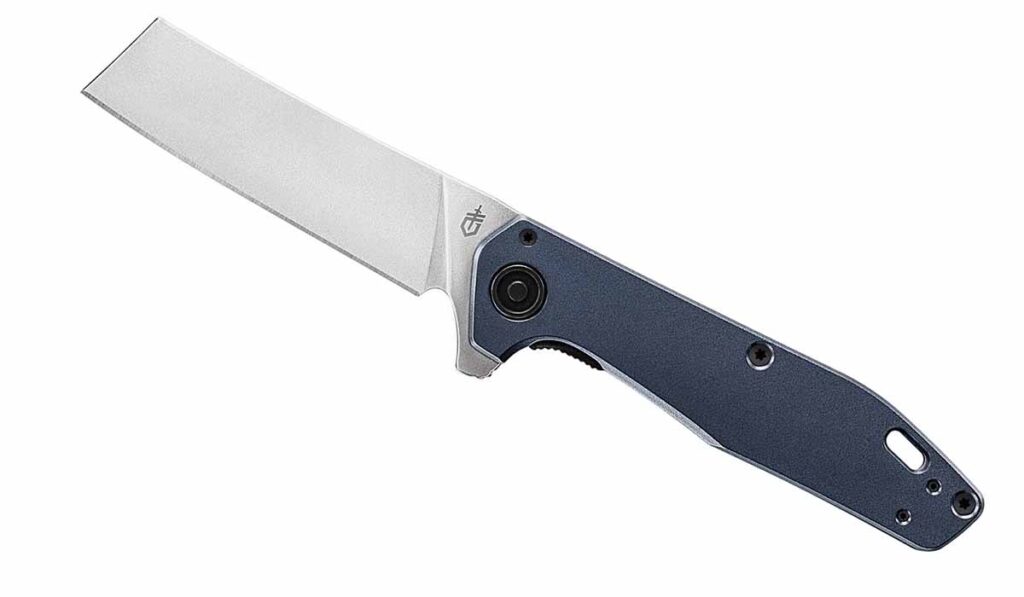
The Fastball is a great knife, but for me (and everyone I could find in an informal inter-office survey of about 20 people) the Cleaver version is just superior.
It features a ball-bearing action with a precision detent and a robust liner lock mechanism that works well. The real highlight is the hefty 3-inch cleaver-style blade is it’s great for regular EDC tasks, camp kitchen prep, and anything else you can think of.
The blade is ground very flat and relatively thin at just .11 inches, making it an incredibly good slicer, as well as something you can depend on for relatively detailed work despite the .88-inch blade width. That hefty cleaver profile helps with quite a few tasks and is surprisingly useful for opening packages and such as well.
The 20CV steel is a great choice as well, as it sharpens well while also holding an edge for quite a while. In testing, it held an edge about twice as long as 440C. While more prone to edge damage, it held an edge longer than M390 as well (another incredibly prolific and popular EDC steel).
Terracraft

Bushcrafters, survivalists, and wilderness enthusiasts, this one is for you. The Terracraft, along with the Sedulo, is part of Gerber’s new Reserve lineup. The Reserve label is, well, reserved for their premium, American-made offerings.
The Terracraft features a CPM S30V blade that has a thick drop point profile, and a 90-degree spine for easy fire starting with a ferro rod. The handle is a beautifully contoured G10 that is sculpted to provide maximum grip even with wet or gloved hands.
If you’re out in the woods a lot and need a fixed blade, the Terracraft is a phenomenal option, especially if you’re a backcountry hunter, bushcrafter, or just like being able to do everything with just one knife.
Empower

The Empower is another great EDC knife that fits in the same general niche as the regular Fastball. It has a 3.25-inch S30V blade with a black oxide coating that gives it a more tactical look than the Fastball.
The Armored Grip handles are very high-friction and perfect for use with gloves or wet hands. The rest of the handle is coated with a Type III hard anodization that will stand up to hard use, or to years of riding around in a pocket.
Like all of Gerber’s US-made stuff, it has a lifetime warranty as well, so you know you’re covered if anything does go wrong, which is always great to know.
River Master (Blackie Collins Clip Lock)

Alright, so technically Blackie Collins helped this publication, but I promise that’s not why his knife is on the list. The man had around 100 knife mechanism and design patents and is the inventor of the assisted opening mechanism that so many folding knives use today.
Having said that, I’m including the River Master on here because 1) It’s a great knife and 2) Blackie passed in 2011 and the knife was discontinued so there’s not really a conflict of interest here, and 3) I was stealing my dad’s River Master out of the tackle box 15 years ago before I ever worked here or heard of the guy. I just knew it was a great knife.
The River Master is a dive-style fixed blade with a handle that is all one piece of stainless so there’s very little chance of anything breaking, or of rust hiding in a gap under a scale or anything like that.
If you’re looking for a classic dive knife, the Clip Lock, specifically the River Master, is a great one to search for on the secondary market.
Final Verdict on Gerber Knives
Gerber is a name you’d probably already heard of before you opened this article, but you may not have known much about it. Hopefully, we’ve rectified that and opened your eyes to some of the great knives from this industry giant.
More Gerber Knives:
- How The Gerber LST Changed Pocketknives Forever
- Gerber Devour Titanium
- Gerber Center-Drive Rescue
- Geber Fuse
 NEXT STEP: Download Your Free KNIFE GUIDE Issue of BLADE Magazine
NEXT STEP: Download Your Free KNIFE GUIDE Issue of BLADE Magazine
BLADE’s annual Knife Guide Issue features the newest knives and sharpeners, plus knife and axe reviews, knife sheaths, kit knives and a Knife Industry Directory.Get your FREE digital PDF instant download of the annual Knife Guide. No, really! We will email it to you right now when you subscribe to the BLADE email newsletter.






